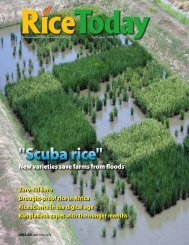How much water does rice need? - adron.sr
How much water does rice need? - adron.sr
How much water does rice need? - adron.sr
Create successful ePaper yourself
Turn your PDF publications into a flip-book with our unique Google optimized e-Paper software.
William Sta. Clara (2)EXTREME WEATHER events such as floods and typhoons are predicted to become more frequent.deep, an international team extracteda record of the climate for the past400,000 years. Present-day levels ofthe greenhouse gases carbon dioxide(around 385 parts per million) andmethane (1,700 parts per billion byvolume) are unprecedented duringthe past 420,000 years: previousmaximum values were 280 parts permillion and 773 parts per billion.A picture of the periodic natureof the glacial and interglacialperiods emerged, as well as thecorrelation between componentsof the climate changing more orless in phase. Four glacial periods,each lasting about 100,000 years,were separated by relatively briefwarm interglacial periods.Without energy from the Sunand the atmosphere, there could beno climate or life. The eccentricityof Earth’s orbit around the Sunvaries, Earth tilts and wobbles onits axis, and these factors influencethe amount and distribution of solarenergy incident over land and seaon the surface of the planet. Suchfactors are grouped together andcalled orbital forcers of climatechange. Cores of marine sedimentsare used to analyze past climates upto 180 million years ago and, on thistime scale, tectonic events becomepart of the climate-forcing factors.To understand greenhouse gasforcing of climate requires a smalldigression. At a “stable” averageenvironmental temperature, theradiation entering Earth’s atmosphereequals the amount leaving. Increasingconcentrations of greenhouse gasesin the atmosphere absorb moreof the infrared radiation. To reestablishthe zero-sum radiationbalance, the emission of long-waveinfrared radiation has to increase.To achieve this, temperaturesmust rise and thus either force oramplify climate change. On top ofthis, some of the changes in pastclimates have yet to be explained.The Vostok record shows that, inthe absence of the billions of humansinhabiting the planet, the next phaseof global climate change would bea gradual drift into an ice age. Thebreak from glacial to interglacialperiods has been accompanied byincreases in the concentrations ofgreenhouse gases. Modern humansascended from caves to skyscrapersduring the past 20,000 years ofthe most recent warming period.The prospect of ice sheetsgrinding down through NorthAmerica and Europe will be achilling one for my progeny. Butmy problem is global warming. Theevidence suggests that the world isgetting warmer and it would be mostodd if increasing concentrationsof greenhouse gases and otheranthropogenic gaseous emissionswere not playing a significant,albeit somewhat obscure, role.The key question, of course, is,What will happen? Will it suddenlyget 6°C hotter? Will the polar capspartly melt, causing sea levels torise by several meters? Will thefuture course of climate change bealtered irreversibly by the activitiesof humankind? I don’t know—butneither <strong>does</strong> anyone else.Weather disasters could becomethe normal human experience overthe coming century. When extremevariation in the weather makesclimate a variable, agriculture ceasesto be an industry and becomes adesperate struggle for survival.What is the InternationalRice Research Institute (IRRI)doing? IRRI has a long historyof climate research and, over thepast few years, has scaled up itsactivities in that area, includingthe establishment of the Riceand Climate Change Consortium.The Institute is ramping up itsdevelopment of <strong>rice</strong> varieties thatare flood, drought, and salt tolerant,fast growing, and high yielding,and crop management practicesthat are robust and flexible.The development of technologiesand skills for increasing food suppliesand raising living standards musttake account of the likelihood ofdrastic changes in the weather. Asignificant part of IRRI’s agenda mustfocus on how to cope with the worstof expected future circumstance<strong>sr</strong>ather than the best of prevailingcircumstances. A substantial partof the Institute’s experimentalfarm should be dedicated to thatend. A Climate Change DisasterCenter would allow us to test ourconcepts and train our partnersfor the worst. Varieties that canprovide food in a hotter, more CO 2 -rich and uncertain world of violentweather extremes have become, andmust continue to be, a priority.By the way, <strong>does</strong> anyone have ahectare of land at about 200 metersabove sea level in the tropics for sale?Rice Today January-March 200939

















